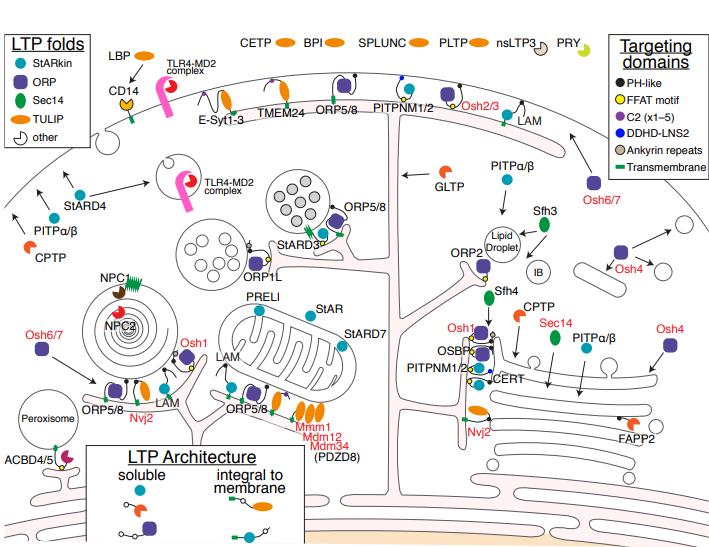Lipid Transfer Proteins (LTPs) Analysis Service
What are LTPs?
Lipid Transfer Proteins (LTPs) are a diverse group of proteins that play a vital role in lipid transport and metabolism in various organisms. These proteins possess the remarkable ability to bind and transfer lipids across biological membranes. LTPs are found in plants, animals, and microorganisms, underscoring their fundamental importance in biological processes.
The significance of LTPs has captivated the attention of researchers, given their essential involvement in crucial cellular functions. Exploring LTPs and analyzing their properties provides valuable insights into the mechanisms of lipid transport, lipid signaling, membrane remodeling, and lipid-based defense systems. By delving into the intricate world of LTPs, scientists aim to unravel the enigmatic aspects of lipid metabolism and the multifaceted roles played by LTPs in diverse biological contexts.
 Lipid transfer proteins (Wong et al., 2019)
Lipid transfer proteins (Wong et al., 2019)
Why Analyze LTPs?
1. Unraveling Lipid Transport Mechanisms:
LTPs are key players in lipid transport between cellular compartments and across biological membranes. By studying LTPs, researchers can elucidate the molecular mechanisms involved in lipid transfer, including the binding, encapsulation, and transport of lipids. This knowledge contributes to a deeper understanding of how cells maintain lipid homeostasis and regulate lipid metabolism.
2. Investigating Cellular Processes:
LTPs are involved in critical cellular processes such as membrane remodeling, lipid signaling, and lipid-based defense mechanisms. Analyzing LTPs helps researchers explore the specific roles these proteins play in these processes. For example, understanding the functions of plant LTPs aids in deciphering cuticle formation, pollen development, stress responses, and defense against pathogens. Animal LTPs have been associated with lipid metabolism, transport, and signaling pathways, while microbial LTPs contribute to lipid metabolism in bacteria and fungi.
3. Identifying Biomarkers and Therapeutic Targets:
LTPs hold potential as biomarkers for various diseases and as targets for therapeutic interventions. Analyzing LTPs in disease states can reveal alterations in their expression levels or modifications, providing valuable insights into the pathogenesis of lipid-related disorders. Furthermore, identifying specific LTPs involved in disease processes can lead to the development of targeted therapies aimed at modulating their activity or expression.
4. Improving Food Quality and Safety:
LTPs are relevant in the context of food science and nutrition. Analyzing LTPs in food samples helps assess lipid content, stability, and potential allergenicity. By understanding the behavior of LTPs in different food matrices, researchers can develop strategies to improve food processing, storage, and prevent lipid-related quality issues.
5. Advancing Biotechnological Applications:
LTPs have potential applications in biotechnology and industrial processes. Their lipid-binding capabilities make them useful in lipid-based drug delivery systems, enzymatic reactions, and lipid-based biosensors. Analyzing LTPs aids in identifying and characterizing suitable candidates for these applications, paving the way for innovative biotechnological solutions.
LTPs Analysis Services in Creative Proteomics
Creative Proteomics offers comprehensive LTPs analysis services tailored to researchers across various domains. With our expertise and advanced facilities, we provide a range of solutions for LTPs analysis. Our services encompass:
Protein Identification and Characterization: Through the integration of advanced mass spectrometry techniques and bioinformatics analysis, we accurately identify and characterize LTPs. By analyzing protein samples' mass and fragmentation patterns, we determine the identity of LTPs and gain insights into their structural features, post-translational modifications, and sequence variations.
Quantitative Analysis: Our quantitative proteomics approaches enable accurate quantification of LTPs in diverse samples. By comparing protein expression levels between samples, we identify differentially expressed LTPs under specific experimental conditions. This quantitative information is essential for comprehending the dynamic changes and regulatory mechanisms of LTPs in various biological processes.
Structural Analysis: Using cutting-edge techniques such as X-ray crystallography and other structural determination methods, we elucidate the three-dimensional structure of LTPs. This structural information provides valuable insights into the folding patterns, secondary structures, and spatial arrangement of LTPs, facilitating a deeper understanding of their functions and interactions with lipid molecules.
Functional Analysis: We employ a range of in vitro and in vivo assays to assess the lipid-binding affinity, transfer activity, and enzymatic functions of LTPs. These functional analyses shed light on the roles and mechanisms of LTPs in lipid transport and metabolism, unraveling their functional significance in biological systems.
LTPs Analysis Instruments
- Liquid Chromatography Systems: Creative Proteomics utilizes advanced liquid chromatography systems, such as Agilent 1290 Infinity II and Thermo Scientific Ultimate 3000, for protein separation and purification in LTPs analysis. These systems employ various chromatographic techniques, such as reversed-phase chromatography and size-exclusion chromatography, to separate and isolate LTPs from complex biological samples.
- Mass Spectrometry Instruments: Creative Proteomics employs state-of-the-art mass spectrometry instruments, such as Thermo Scientific Orbitrap Fusion Lumos and Waters Xevo G2-XS QTOF, for protein identification, characterization, and quantitative analysis of LTPs. These instruments offer high-resolution and accurate mass measurements, allowing for the identification of LTPs and the detection of post-translational modifications with exceptional sensitivity.
- Electrophoresis Systems: Electrophoresis plays a crucial role in the characterization of LTPs, and Creative Proteomics utilizes advanced electrophoresis systems for protein analysis. Instruments like Bio-Rad Criterion and Thermo Scientific SurePAGE are used for SDS-PAGE (Sodium Dodecyl Sulfate-Polyacrylamide Gel Electrophoresis), enabling the separation and visualization of LTPs based on their molecular weights.
- Nuclear Magnetic Resonance (NMR) Spectrometers: NMR spectroscopy is employed by Creative Proteomics to study the structure and dynamics of LTPs. Instruments such as Bruker AVANCE III HD and Agilent 700 MHz NMR Spectrometer are utilized for high-resolution solution-state NMR analysis. NMR spectroscopy provides information on the conformation, interactions, and dynamics of LTPs in solution.
Analyzable LTPs and their Respective Organisms (including but not limited to)
| LTP Name | Organism |
|---|
| LTP1 | Plants |
| LTP2 | Plants |
| LTP3 | Plants |
| Fatty Acid-Binding Protein (FABP) | Animals (vertebrates) |
| Insect LTP-like Protein | Insects |
| Non-Specific LTP (nsLTP) | Various organisms |
| Microbial LTPs | Bacteria, fungi |
Sample Requirements for LTPs Analysis
To ensure accurate and reliable LTPs analysis, Creative Proteomics has specific sample requirements. They accept various sample types, including:
- Plant Tissues: Leaf samples, seed samples, and other plant tissues are commonly analyzed to study plant LTPs. Fresh samples are preferred, but frozen samples can also be used depending on the analysis requirements.
- Microbial Cultures: For microbial LTPs analysis, we accept microbial cultures, including bacteria and fungi. The sample quantity should be sufficient for protein extraction and analysis.
- Food and Food Products: We accept a wide range of food samples for LTPs analysis, including oils, nuts, grains, and processed food products. The sample quantity required may vary depending on the specific analysis requested.
- Other Samples: We accommodate other sample types based on the specific project requirements. Custom sample types can be discussed with their experts to determine feasibility and analysis options.
Reference
- Wong, Louise H., Alberto T. Gatta, and Tim P. Levine. "Lipid transfer proteins: the lipid commute via shuttles, bridges and tubes." Nature reviews Molecular cell biology 20.2 (2019): 85-101.
* Our services can only be used for research purposes and Not for clinical use.
Services:


 Lipid transfer proteins (Wong et al., 2019)
Lipid transfer proteins (Wong et al., 2019)
